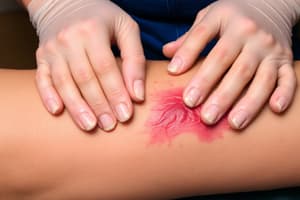Podcast
Questions and Answers
A patient with which condition is LEAST likely to be assessed using the Braden Scale for pressure ulcer risk?
A patient with which condition is LEAST likely to be assessed using the Braden Scale for pressure ulcer risk?
- Anxiety disorder with intact communication abilities. (correct)
- Long-term urinary incontinence
- Stroke with unilateral paralysis.
- Compromised sensory perception due to nerve damage
Which of the following rationales BEST explains why altered mental status increases the risk of pressure injuries?
Which of the following rationales BEST explains why altered mental status increases the risk of pressure injuries?
- Changes in mental status directly affect skin integrity.
- Heightened pain perception causes patients to avoid movement.
- Increased metabolic rate leads to faster tissue breakdown.
- Reduced awareness impairs communication and repositioning. (correct)
A patient at risk for pressure injuries is being discharged. Which intervention should the nurse prioritize in the discharge plan?
A patient at risk for pressure injuries is being discharged. Which intervention should the nurse prioritize in the discharge plan?
- Schedule follow-up blood work for albumin levels.
- Educate on the importance of a high-caffeine diet
- Instruct on limiting fluid intake to manage incontinence.
- Demonstrate proper use of pressure-relieving devices. (correct)
Which blood test is MOST useful in monitoring the nutritional status of a patient at risk for pressure injuries?
Which blood test is MOST useful in monitoring the nutritional status of a patient at risk for pressure injuries?
What is the MOST appropriate method of assisting a patient with limited upper body strength to move up in bed and reduce the risk of skin shearing?
What is the MOST appropriate method of assisting a patient with limited upper body strength to move up in bed and reduce the risk of skin shearing?
An incontinent patient is on a voiding schedule. Which intervention is MOST important to include in their care plan to prevent skin breakdown?
An incontinent patient is on a voiding schedule. Which intervention is MOST important to include in their care plan to prevent skin breakdown?
An incontinent patient develops a pressure injury. Besides the pressure injury, which secondary complication is MOST likely to arise?
An incontinent patient develops a pressure injury. Besides the pressure injury, which secondary complication is MOST likely to arise?
Besides pressure injuries, what other potential issue should healthcare providers monitor for in a poorly cared for, incontinent patient?
Besides pressure injuries, what other potential issue should healthcare providers monitor for in a poorly cared for, incontinent patient?
Which of the following observations during a mental status examination directly assesses a patient's emotional expressions?
Which of the following observations during a mental status examination directly assesses a patient's emotional expressions?
A caregiver is experiencing role strain while caring for their mother who has dementia. What initial nursing intervention is most appropriate to gather more information about the caregiver's stress?
A caregiver is experiencing role strain while caring for their mother who has dementia. What initial nursing intervention is most appropriate to gather more information about the caregiver's stress?
What is a key feature that differentiates specialized dementia or Alzheimer's units from a typical home environment in order to meet the needs of residents?
What is a key feature that differentiates specialized dementia or Alzheimer's units from a typical home environment in order to meet the needs of residents?
A family member asks if there are treatments available to reverse their spouse's recent diagnosis of Alzheimer's disease. What is the most appropriate response?
A family member asks if there are treatments available to reverse their spouse's recent diagnosis of Alzheimer's disease. What is the most appropriate response?
An elderly patient in the hospital is suddenly exhibiting new-onset confusion, pacing, and is pulling at their IV line. Which condition is the most likely cause of these changes?
An elderly patient in the hospital is suddenly exhibiting new-onset confusion, pacing, and is pulling at their IV line. Which condition is the most likely cause of these changes?
A patient with a history of stroke-related paralysis is admitted. Which of the following interventions is MOST crucial for preventing falls, considering their specific risk factors?
A patient with a history of stroke-related paralysis is admitted. Which of the following interventions is MOST crucial for preventing falls, considering their specific risk factors?
A patient with altered mental status is at high risk for falls. Which of the following nursing interventions is MOST appropriate to implement?
A patient with altered mental status is at high risk for falls. Which of the following nursing interventions is MOST appropriate to implement?
A patient taking antihypertensive medication is being discharged. Which of the following home safety modifications would be MOST important to recommend to prevent falls?
A patient taking antihypertensive medication is being discharged. Which of the following home safety modifications would be MOST important to recommend to prevent falls?
When transferring a patient with known balance issues to the restroom, which assistive device is MOST appropriate to ensure their safety?
When transferring a patient with known balance issues to the restroom, which assistive device is MOST appropriate to ensure their safety?
You observe signs of potential abuse on a patient. What is the MOST appropriate initial action according to reporting protocols?
You observe signs of potential abuse on a patient. What is the MOST appropriate initial action according to reporting protocols?
A patient who uses a walker is being supervised while walking on a sidewalk. What specific environmental hazard poses the GREATEST risk for falls?
A patient who uses a walker is being supervised while walking on a sidewalk. What specific environmental hazard poses the GREATEST risk for falls?
An elderly patient at home is identified as a fall risk, particularly at night. What is the MOST important instruction to give to the patient regarding nighttime safety?
An elderly patient at home is identified as a fall risk, particularly at night. What is the MOST important instruction to give to the patient regarding nighttime safety?
A patient with Alzheimer's disease is repeatedly found wandering in the hallway. What is the MOST appropriate nursing intervention?
A patient with Alzheimer's disease is repeatedly found wandering in the hallway. What is the MOST appropriate nursing intervention?
Flashcards
Affect (Mental Status)
Affect (Mental Status)
Emotional expressions displayed by a person.
Appearance (Mental Status)
Appearance (Mental Status)
Assessment of patient's dress, hygiene, and overall presentation.
Caregiver Role Restraint
Caregiver Role Restraint
Difficulties managing the responsibilities and stress of caring for someone.
Dementia Unit Success Factors
Dementia Unit Success Factors
Signup and view all the flashcards
Delirium
Delirium
Signup and view all the flashcards
Pressure Ulcer Risk Factors
Pressure Ulcer Risk Factors
Signup and view all the flashcards
Braden Scale
Braden Scale
Signup and view all the flashcards
Pressure Injury Prevention
Pressure Injury Prevention
Signup and view all the flashcards
Pressure Injury Blood Tests
Pressure Injury Blood Tests
Signup and view all the flashcards
Safe Patient Transfer
Safe Patient Transfer
Signup and view all the flashcards
Voiding Routine Frequency
Voiding Routine Frequency
Signup and view all the flashcards
Incontinence Complications
Incontinence Complications
Signup and view all the flashcards
Signs of Poor Incontinence Care
Signs of Poor Incontinence Care
Signup and view all the flashcards
Fall Risk Factors
Fall Risk Factors
Signup and view all the flashcards
Home Fall Hazards
Home Fall Hazards
Signup and view all the flashcards
Fall Prevention Measures
Fall Prevention Measures
Signup and view all the flashcards
Fall Risk Identification
Fall Risk Identification
Signup and view all the flashcards
Gait Belt Use
Gait Belt Use
Signup and view all the flashcards
Abuse Reporting Protocol
Abuse Reporting Protocol
Signup and view all the flashcards
Nighttime Fall Prevention
Nighttime Fall Prevention
Signup and view all the flashcards
Wandering Patient Intervention
Wandering Patient Intervention
Signup and view all the flashcards
Study Notes
- Risk factors for pressure ulcers include being bedridden, immobile, or experiencing stroke-related paralysis.
- Nerve damage that compromises pain perception and feelings is a risk factor, as is incontinence.
- Use the Braden Scale to assess risk factors, considering sensory perception, mobility, friction, and nutrition.
- Pressure injury problems are linked to impaired communication, lack of awareness, and delays in getting help.
Interventions for Pressure Injuries
- Reposition patients every 2 hours for universal pressure injury prevention.
- Use pressure-relieving devices such as air mattresses, heel protectors, and wedges.
- Use gel seat cushions, inflatable waffle cushions, air mattresses, or memory foam in wheelchairs, directing patients to shift weight.
Blood Work and Pressure Injuries
- Prealbumin levels (normal range: 15-36ml/dl) are relevant.
- Monitor WBC to track infection progress.
- Anemia and dehydration are not directly related to pressure injuries.
Preventing Injuries When Moving Patients
- Use transfer devices like a Hoyer lift, mechanical lift, overhead trapeze, or friction sheet.
Managing Incontinence
- Implement voiding routines and bladder and bowel training programs, taking patients to the restroom every two hours.
- Clean and dry patients after accidents, applying skin protectant before reapplying the diaper.
- Educate them about voiding and advise against caffeinated drinks like coffee, tea, and soda.
- Incontinent patients are more likely to get pressure injuries and infections (UTIs such as cystitis or pyelonephritis).
- Poor care of incontinent patients can lead to rash (dermatitis).
Falls
- Risk factors for falls include poor balance (stroke, paralysis) and altered mental status or confusion.
Home Safety
- Look for loose rugs, lighting issues, clutter, and lack of assistive devices.
- Hospitals have grab bars (showers, room), shower chairs, and railings.
Fall Risk Patients
- Check on patients hourly.
- Constantly remind them to call for help.
- Use bed alarms to monitor when they are getting up.
- Fall risk is indicated by a fall risk band, a falling star outside the door with the patient's name, and notations for NPO, allergies, and code status (DNR).
- Use a gait belt for patients with balance issues.
Abuse Reporting
- Report to the supervisor first, then the ombudsman, and law enforcement if an injury is suspected.
Walker Use
- When supervising a patient using a walker on the sidewalk, be aware of curbs.
- To navigate a curb, pick up the walker and lift it.
- Night lights are good for patients.
- Alzheimer's patients need to be redicrected.
Caregiver Role Strain
- Symptoms include irritability, changes in physical appearance, weight loss and eye bags.
Mental Status Examination
- Affect (emotional expressions), patient behavior and appearance and memory (short-term and long-term) are measured.
- Active listening and asking open-ended questions can help discover underlying sources of stress.
- Successful dementia units offer scheduled activities, routines, limit choices.
- Dementia is not reversible, while delirium is acute.
- Delirious elderly patients may pace, talk to themselves, hear things, climb out of bed, yell, scream, or become combative.
- Advise patients that are about to pee to hold their breath.
Studying That Suits You
Use AI to generate personalized quizzes and flashcards to suit your learning preferences.
Related Documents
Description
Examine the risk factors for pressure ulcers, including immobility, nerve damage, and incontinence. Learn appropriate interventions include repositioning patients and using pressure-relieving devices. Also, learn about the role of blood work, especially prealbumin levels, in pressure injury management.





